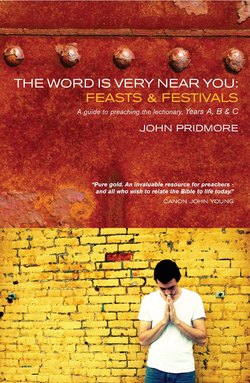Читать книгу The Word is Very Near You: Feasts and Festivals - John Pridmore - Страница 8
На сайте Литреса книга снята с продажи.
ОглавлениеIntroduction
Christians keep Sunday special – at least they are supposed to. Every Sunday is the day of resurrection, not just Easter Day. But there are weekdays too during the year that are important to Christians. Ash Wednesday and Good Friday are obvious examples. Then there are the festivals, such as Christmas Day, which only occasionally fall on a Sunday. So it is with the saints’ days. St George’s Day, 23 April, for example, will some years be a Sunday, but most years not. It is good for us to keep the saints’ days special, on whatever day of the week they fall. We are not alone. We belong to the extended family of all the saints, those with us still but those too who rejoice ‘on another shore and in a greater light’. We are surrounded by this ‘great cloud of witnesses’ (Hebrews 12.1) and we are glad to give thanks for them on any day of the week.
The Church of England’s ‘Principal Service Lectionary’ provides readings both for Sundays and also for the festivals which do not – or do not necessarily – fall on a Sunday. In the first volume of The Word is Very Near You (Canterbury Press, 2009) I commented on the lectionary’s three-year cycle of readings for the Sundays of the church year. This slimmer second volume focuses on the church’s high days and holy days that are never on a Sunday or only sometimes on a Sunday. My aim is to explore the themes of these days in the light of the scriptural readings appointed for them.
King Lear, contemplating what he supposed would be indefinite imprisonment with his daughter Cordelia, imagines that they will wile away their time behind bars gossiping about ‘who’s in, who’s out’ at court. The same ‘who’s in, who’s out’ question faced me in having to decide which festivals to include in these pages. Choices had to be made. As an Englishman, I have not presumed to comment on ‘the saints for Ireland, Scotland, and Wales’, although the Church of England lectionary provides readings for their festivals. Because I based these studies on the provisions of the ‘Principal Service Lectionary’, I had to forego commenting on the men and women of God to whom are grudgingly allotted ‘Lesser Festivals’ or mere ‘Commemorations’. Many of these brave and holy people probably mean more to us than those honoured by their red-letter days and a strong case could be made for their promotion to a higher place in the church’s esteem and a more prominent place in its calendar. But that case cannot be made here.
In the end I resolved the ‘who’s in, who’s out’ issue by a simple rule of thumb. The days I mull over are those that are generally observed as ‘principal festivals’ in the Church of England. Rules of thumb, of course, are always rough and ready. It might be felt that there are special days not mentioned here that have as great a claim to be included as those that are discussed. Be that as it may, I am fairly confident that none of the festivals I do consider could lightly have been dropped.
Three explanatory notes are perhaps necessary. First, the lectionary provides three ‘Sets’ of readings which may be used ‘on the evening of Christmas Eve and on Christmas Day’, but it stipulates that ‘Set III
should be used at some service during the celebration’. The passage appointed as the Gospel in the Set III readings is the Prologue to John’s Gospel (John 1.1–14). It is this text above all which compels our attention at Christmas, the attention not least of those who have the unnerving task of expounding it. For this reason, I have based all three Christmas expositions on the Set III readings.
Second, I have taken the opportunity provided by this second series of reflections to include some thoughts on four festivals which are –
necessarily or probably – celebrated on Sundays, but which were not included in the previous volume. These are a Dedication Festival, Bible Sunday, Mothering Sunday and Harvest Thanksgiving.
Third, for the celebration of a Dedication Festival the lectionary provides different readings for years A, B and C. The focus of this festival will usually be on the story of the local church whose dedication is being celebrated. For this reason, I have included just one reflection for this festival, a more general consideration of the role of holy places in the mission of the church.
Many of these pieces were originally published in the Church Times. As I said in the foreword to this book’s predecessor, I am grateful to the deputy editor of the Church Times, Rachel Boulding, for making my comments on the lectionary fit to appear in its pages. My deep gratitude is also due to Christine Smith of Canterbury Press, both for inviting me to prepare these studies for publication in book form and for her patience with my endless tiresome questions.
Again as I acknowledged in the foreword to the earlier book, I owe more than I can say to the encouragement and forbearance of my wife Pat, as I have tried to put into words what often is beyond words.
This book is dedicated to someone who brings to his study of Holy Scripture an immeasurably clearer and more Christian mind than mine. The book would have been much better if he had written it.
John Pridmore
